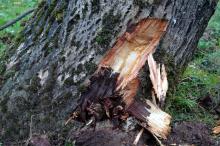Cause Many Phytophthora species, fungus-like microorganisms, cause a root and root crown rot of walnuts. The more important ones in California are P. cinnamomi and P. citricola. After river flooding, however, P. pini was a major problem on walnut scions. Cool, wet, or waterlogged soils favor the disease. Prolonged (24 hours or more) and repeated periods of saturation favor infections. Rootstocks vary in susceptibility to the different Phytophthora species, and none are resistant to all species. In general, Paradox rootstock is more tolerant of several Phytophthora species than is northern California black walnut. The clonal rootstock RX1 has shown moderate to high resistance depending on the Phytophthora species involved. The disease kills young trees because their root systems and root crown areas are small compared to those of mature trees. This is a rare disease problem in Oregon where orchards are on well-drained hillsides.
Symptoms Chronic infections, usually of the roots, cause reduction in growth and early senescence and leaf fall. Terminal shoots may die and foliage may be sparse. These trees may be unthrifty for several years before succumbing to the disease. Root crown rot is characterized by decayed bark at the base of infected trees. A black exudate from the bark may be noticeable. When the bark is stripped away, the cambium is brown with a water-soaked, zonate appearance between white, healthy tissue and brown, diseased tissue. Once crown rot girdles the tree it will collapse and die soon after the first warm weather of spring. Leaves of such trees wilt, dry, and remain attached to the tree. Except for the quick collapse in warm weather, the canopy symptoms are similar to those of blackline or Armillaria root rot.
Cultural control
- Plant orchards on well-drained soil.
- Avoid excessive irrigation that saturates the soil or frequently wets the root crown of the tree.
Chemical control Focus on cultural control methods first. A foliar spray with a phosphonate-based fungicide (Group P7 fungicide) was better than soil drenches of the same material for protection of walnut.
- Agri-Fos at 1.25 quarts/A. Group P7 fungicide. 4-hr reentry. Washington only.
- ArborFos (from Mauget) can be injected into trees at a rate of 5 ml/inch diameter at breast height. See label for details. Unknown efficacy in the Pacific Northwest. Group P7 fungicide.
- Fosphite at 1 to 3 quarts/A. Do not use copper products within 20 days of treatment and do not use spray adjuvants. Group P7 fungicide. 4-hr reentry.
- MetaStar 2E at 2 gal/A or 6 fl oz/1000 sq ft. Treat the entire root zone; do not concentrate near the base of the tree. Group 4 fungicide. 48-hr reentry.
- Monterey Garden Phos at 2 teaspoons/gal water as a foliar spray. Group P7 fungicide. H
- Orondis at 4.8 to 9.6 fl oz/A as a drench, soil-directed spray or through irrigation water. Do not use within 30 days of harvest. Group 49 fungicide. 4-hr reentry.
- OxiPhos at 2.5 to 5 quarts/A as a foliar spray. Group P7 fungicide. 4-hr reentry.
- Phospho-Jet at 1.25 quarts/125 gal water/A is registered as a foliar spray. Group P7 fungicide. 4-hr reentry.
- Phostrol at 2.5 to 5 pints/A. Group P7 fungicide. 4-hr reentry.
- Rampart at 1 to 3 quarts/100 gal water/A. Do not use copper products within 20 days of treatment. Can also be trunk injected. Group P7 fungicide. 4-hr reentry.
- Ridomil Gold SL at 2 quarts/A in sufficient water to move it into the root zone. Treat the entire root zone; do not concentrate near the base of the tree. Treatment will not revitalize trees with moderate to severe symptoms. Do not apply within 30 days of harvest. Group 4 fungicide. 48-hr reentry.
Reference Browne, G. T., Hasey, J. K., Ott, N. J., Forbes, H., Arnold, K. and Milliron, L. 2021. Flooding by California Rivers Results in Walnut Scion Infections by Species of Phytophthora. Plant Health Progress, https://doi.org/10.1094/PHP-02-20-0011-RS.


